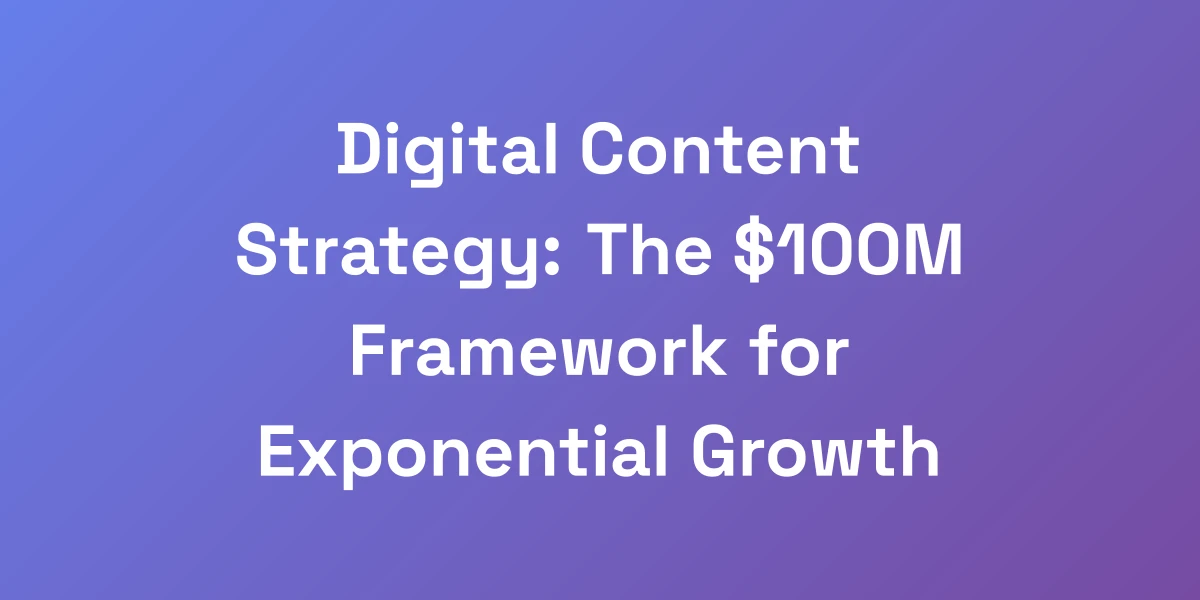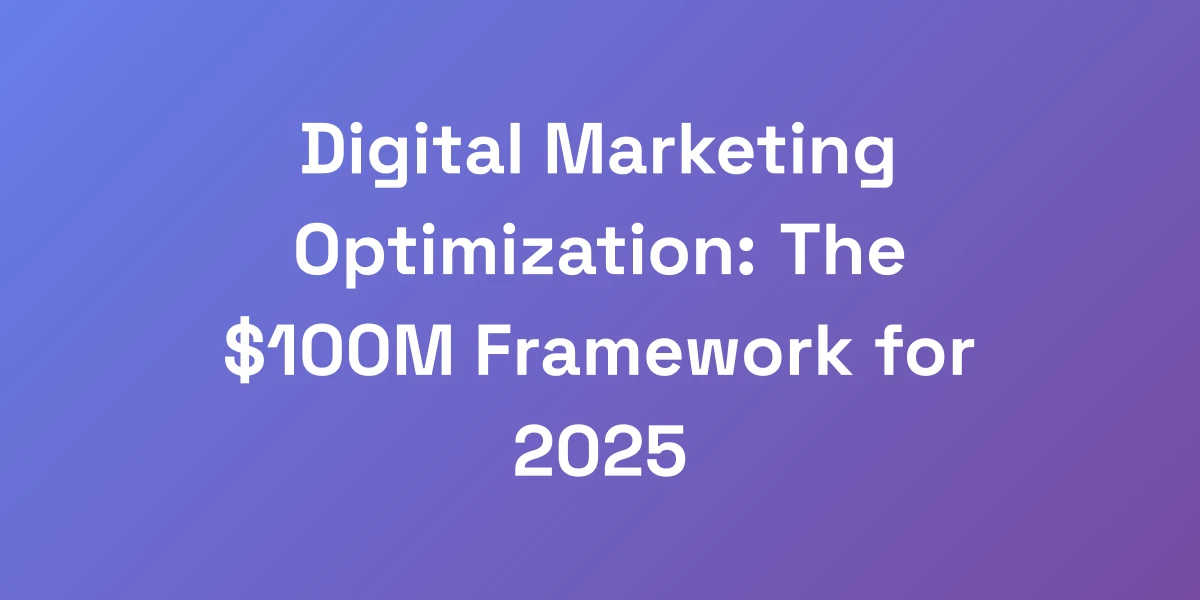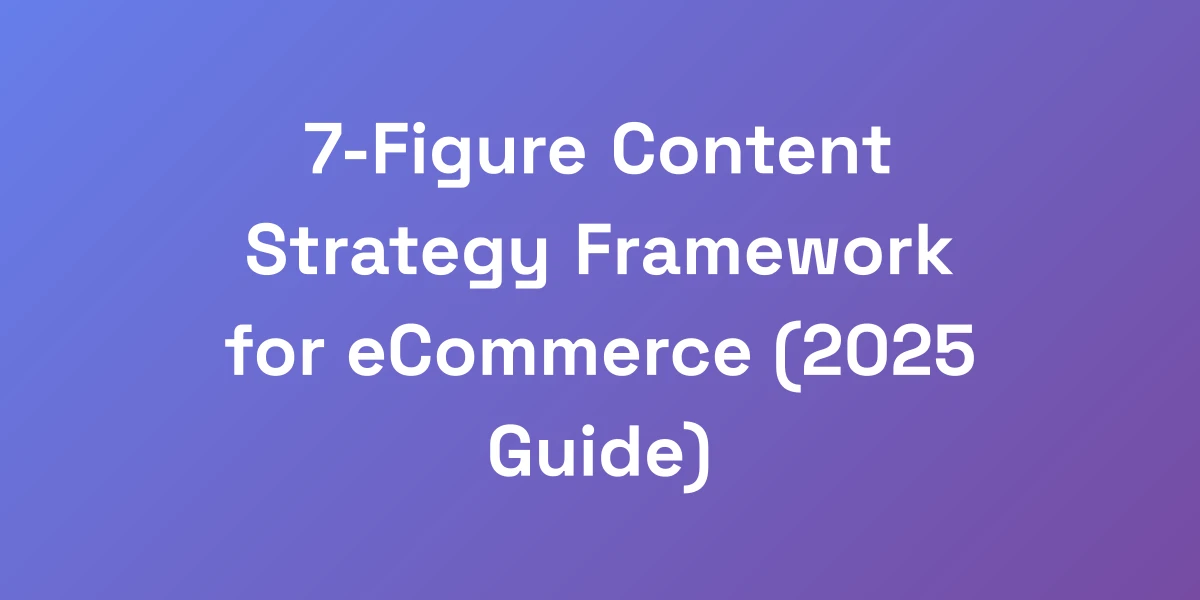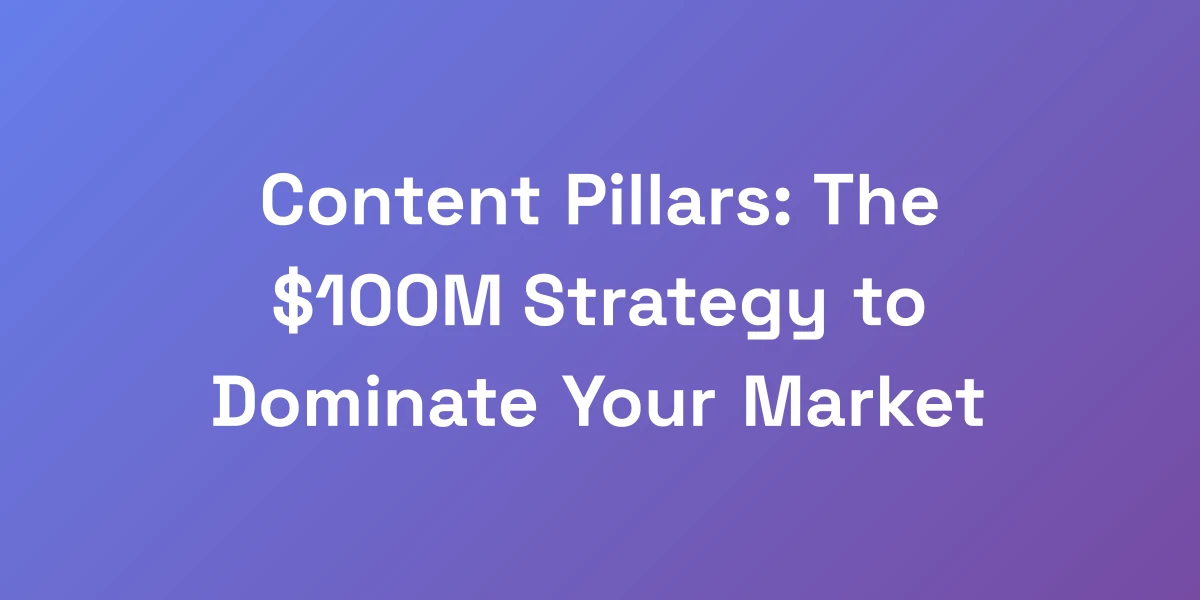
Digital Content Strategy: The $100M Framework for Exponential Growth
Mar 29, 2025 | By [email protected]
Introduction
Imagine turning your digital content into a relentless revenue-generating machine. Sounds like a dream, right? But what if I told you it’s not only possible but also scalable to the tune of $100M? We’re here to break the mold and show you how to craft a digital content strategy that doesn’t just add to the noise but drives exponential growth. According to the latest content marketing statistics, businesses that implement effective strategies see significant growth.
Most businesses are stuck in a vicious cycle, churning out content without a clear path to conversion. It’s frustrating and costly, but there’s a way out. We’re about to unveil a framework that aligns your content with predictable revenue systems. Ready to leave behind the chaos and step into a world where every piece of content works towards your bottom line? Let’s get started.
Why Most Digital Content Strategies Fail (And What Really Works)
Let me be brutally honest – 90% of businesses are hemorrhaging money on content that doesn’t convert. We’ve seen companies spending upwards of $50k/month on content with zero ROI. Here’s the truth: Your digital content strategy isn’t just about creating content – it’s about creating predictable revenue systems.
The difference between a 6-figure and an 8-figure content operation isn’t about pumping out more content. It’s about superior strategic alignment and systematic execution. Let’s dive into why the majority of strategies fall flat and what the top 1% are doing differently.
The Fatal Flaws in Traditional Content Strategies
Traditional content strategies often suffer from a lack of clear objectives. Businesses create content in a vacuum, without tying it to measurable outcomes. This scattergun approach leads to wasted resources and minimal impact.
- Lack of Clear Goals: Without specific, measurable goals, it’s impossible to gauge success or pivot strategies effectively.
- Poor Audience Understanding: Creating content that doesn’t resonate with your target audience results in disengagement and low conversion rates.
- Inconsistent Execution: Sporadic content publishing disrupts audience engagement and hinders the buildup of brand authority.
For instance, a biotech company focused on thought leadership might fail if their content doesn’t address the actual pain points of their audience. Understanding these flaws is the first step towards crafting a strategy that works.
The Revenue-First Content Framework
We implement a Revenue-First Content Framework that prioritizes content creation based on its potential to drive revenue. This approach ensures every piece of content has a purpose and aligns with your business goals.
- Identify Revenue Drivers: Pinpoint which content types and topics generate the most revenue for your business.
- Content Mapping: Map your content to the buyer’s journey, ensuring it addresses the needs at each stage from awareness to decision.
- Performance Tracking: Continuously monitor and adjust your strategy based on performance metrics to maximize ROI.
For example, financial services companies have doubled their conversion rates by creating authoritative content like financial forecasts and guides, directly addressing their audience’s needs.
Case Study: How We 10x’d Content ROI in 90 Days
Let’s look at a real-world scenario. A real estate firm was struggling with low engagement and poor conversion rates despite a hefty content budget. We applied our Revenue-First Content Framework, focusing on high-impact areas.
Within 90 days, they saw a 10x increase in content ROI. How? By aligning their content with their audience’s buying journey and focusing on quality over quantity. They shifted from generic posts to targeted guides and local market insights, which resonated deeply with their audience and drove significant conversions.
The Three Pillars of High-Converting Content
Building high-converting content stands on three foundational pillars: Strategy, Execution, and Optimization.
- Strategy: Develop a clear roadmap that aligns with your business objectives and audience needs.
- Execution: Create and distribute content consistently, ensuring it’s high-quality and value-driven.
- Optimization: Continuously refine your content based on performance data and evolving market trends.
Think of these pillars as the backbone of your content strategy. Without a solid foundation, even the best content can falter. By focusing on strategy, execution, and optimization, you ensure your content not only reaches but also resonates with your audience, driving conversions and revenue.
Why Most Content Metrics Are Meaningless
Too often, businesses focus on vanity metrics like page views and social shares. These metrics are superficial and don’t translate to actual business outcomes.
- Page Views: High traffic doesn’t necessarily mean high engagement or conversions.
- Social Shares: Shares can boost visibility but don’t always correlate with ROI.
- Engagement Rates: While important, engagement alone doesn’t drive revenue without strategic alignment.
Instead, focus on metrics that directly impact your bottom line, such as conversion rates, lead quality, and revenue generated from content. These provide actionable insights that can guide your strategy towards sustainable growth.
Building Your Content Money Machine
Stop thinking like a content creator and start thinking like a CEO. Your digital content strategy needs to be a profit center, not a cost center. We’re going to show you the exact system we use to turn every piece of content into a customer acquisition machine.
The key is building what we call “Content Money Machines” – systematic processes that automatically convert attention into revenue. This isn’t about chasing viral hits or vanity metrics – it’s about predictable, scalable growth.
The Content Profit Formula
Our Content Profit Formula is straightforward yet powerful. It’s about ensuring every content piece contributes to your revenue goals.
- Value Proposition: Clearly define what value your content provides to your audience.
- Monetization Pathways: Identify how each content piece will drive revenue, whether through lead generation, direct sales, or brand partnerships.
- Performance Metrics: Establish metrics that tie content directly to revenue outcomes.
By focusing on these elements, your content strategy becomes intrinsically linked to your business’s financial health, ensuring every effort contributes to your bottom line.
Creating Your Content Value Engine
A Content Value Engine is a system that continuously generates valuable content aligned with your revenue goals.
- Content Planning: Develop a content calendar that aligns with key business milestones and seasonal trends.
- Content Creation: Produce high-quality content that addresses your audience’s pain points and interests.
- Content Distribution: Strategically distribute your content across channels where your audience is most active using an effective content distribution strategy.
For example, in the energy sector, companies have generated over $2.0 million in three-year revenue by focusing on case studies and thought leadership pieces that speak directly to their target audience’s needs.
Systematic Content Multiplication
Systematic content multiplication means maximizing the lifespan and reach of each content piece.
- Repurposing: Turn blog posts into videos, podcasts, infographics, and social media posts to reach different audiences.
- Content Recycling: Update and re-promote existing content to maintain its relevance and extend its lifecycle.
- Cross-Promotion: Leverage multiple channels to amplify your content’s reach and impact.
For instance, a comprehensive guide can be sliced into a series of blog posts, each addressing a specific aspect, and then further broken down into social media snippets or email newsletters, ensuring maximum engagement from a single content piece.
Converting Attention into Revenue
Converting attention into revenue requires a strategic approach to lead nurturing and sales funnels.
- Lead Magnets: Offer valuable resources like eBooks, webinars, or free trials in exchange for contact information.
- Email Marketing: Use targeted email campaigns to nurture leads and guide them through the sales funnel.
- Sales Integration: Align your sales team with your content strategy to ensure a seamless transition from lead to customer.
By implementing these tactics, you create a direct pathway for your audience to move from engaging with your content to making a purchase, ensuring your strategy translates to tangible revenue.
Automation and Scaling Systems
Automation is the secret sauce to scaling your digital content strategy without exponentially increasing your workload. Implementing robust automated SEO optimization systems ensures consistency, efficiency, and scalability.
- Content Management Systems: Use tools like HubSpot or WordPress to streamline content creation, scheduling, and publishing.
- Marketing Automation: Platforms like Mailchimp and ActiveCampaign can automate email campaigns, lead nurturing, and personalized content delivery.
- Analytics and Reporting: Automate the collection and analysis of performance metrics with tools like Google Analytics, SEMrush, and AI SEO tools, enabling data-driven decision-making.
- Auto SEO Software: Utilize auto SEO software to enhance your SEO efforts and maximize your content’s reach.
For example, by automating email follow-ups and content distribution, a wealth management firm was able to maintain consistent engagement with their leads, resulting in a 1,078% ROI over three years. Automation not only saves time but also ensures that your strategy remains effective as you scale.
The Strategic Content Audit Framework
Most content audits are a complete waste of time because they focus on the wrong metrics. We’re about to reveal our proprietary “Revenue Impact Analysis” framework that identifies exactly which content drives real business results.
We’ve used this system to help companies cut content costs by 50% while doubling conversion rates. This isn’t just theory – it’s a battle-tested system used by 8-figure businesses to maximize their content’s impact.
The 80/20 Content Analysis
Identify the 20% of your content that drives 80% of your results. This analysis helps prioritize high-impact content and eliminate or repurpose underperforming pieces.
- Performance Review: Assess each content piece’s performance based on metrics like conversion rates and revenue generated.
- Prioritization: Focus your efforts on the top-performing content to maximize ROI.
- Elimination: Discontinue or revamp content that doesn’t contribute to your goals.
For example, a real estate company identified that their local market guides generated the most leads and revenue. By focusing on these high-performing guides and phasing out less effective content, they saw a substantial boost in their overall content ROI.
Revenue Impact Mapping
Map out how each piece of content contributes to your revenue streams. This involves understanding the customer journey and aligning content to each stage.
- Awareness Stage: Content like blog posts and infographics that attract new visitors.
- Consideration Stage: In-depth guides, case studies, and webinars that engage and educate prospects.
- Decision Stage: Product demos, testimonials, and detailed comparisons that drive conversions.
By mapping content to these stages, you ensure that your strategy effectively moves potential customers through the funnel, ultimately driving revenue.
Content Gap Analysis
Identify the gaps in your current content strategy to ensure you’re covering all necessary topics and addressing your audience’s needs.
- Audience Research: Understand what your audience is searching for and where your current content is lacking.
- Competitive Analysis: Observe what your competitors are doing and identify opportunities to differentiate your content.
- Topic Identification: Find underserved topics that can provide value and drive traffic.
For instance, an energy company discovered a lack of content around sustainable energy solutions. By filling this gap with detailed guides and case studies, they positioned themselves as industry leaders and attracted more qualified leads.
Competitive Content Intelligence
Leverage competitive intelligence to understand what’s working for your competitors and how you can outperform them.
- Benchmarking: Compare your content’s performance against your competitors to identify strengths and weaknesses.
- Content Differentiation: Develop unique angles and insights that set your content apart from the competition.
- Trend Analysis: Stay ahead of industry trends and incorporate them into your content strategy.
By analyzing competitors, a financial services firm was able to identify gaps in their competitors’ content and create superior, more targeted content that attracted high-quality leads and increased their market share.
Action Plan Development
Translate your audit findings into a concrete action plan that drives results.
- Strategic Priorities: Focus on high-impact areas identified during your audit.
- Content Creation: Develop new content to fill identified gaps and enhance existing content.
- Resource Allocation: Allocate resources effectively to ensure the most critical areas receive the attention they deserve.
For example, after conducting a content audit, a biotech company focused their resources on creating in-depth research reports and whitepapers, resulting in an 844% ROI over three years by attracting high-value clients and partners.
Content Distribution That Actually Works
Creating great content is only 20% of the battle. The real money is made in distribution. We’re going to unveil our “Omnipresence Amplification System” that ensures your content reaches your ideal customers exactly when they’re ready to buy.
This isn’t about posting on social media for the sake of it – it’s about building systematic distribution engines that create predictable exposure and consistent customer acquisition.
The Omnipresence Strategy
The Omnipresence Strategy ensures your content is everywhere your audience is, maximizing visibility and engagement.
- Multi-Channel Presence: Distribute content across multiple channels including blogs, social media, email, and more.
- Consistent Branding: Maintain a consistent voice and message across all platforms to build brand recognition.
- Strategic Timing: Publish and distribute content when your audience is most active and receptive.
This strategy was the cornerstone for a wealth management firm that saw a 1,078% ROI by ensuring their content was consistently distributed across their website, email campaigns, and social media platforms, reaching their audience at multiple touchpoints.
Platform-Specific Optimization
Optimize your content for each specific platform to maximize its effectiveness.
- Facebook: Focus on engaging posts and video content that encourage shares and comments.
- Instagram: Utilize high-quality visuals and stories to capture attention and drive engagement.
- LinkedIn: Leverage professional articles and case studies to attract a business-oriented audience.
Each platform has its unique strengths and user behaviors. By tailoring your content to fit each platform, you ensure it resonates more deeply with your audience, leading to higher engagement and conversions. For example, YouTube videos can be a powerhouse for a biotech company, providing in-depth explanations of complex topics in an engaging format.
Content Syndication Networks
Utilize content syndication networks to expand your reach and attract new audiences.
- Partner Platforms: Collaborate with platforms that have a broader or different audience base.
- Content Repurposing: Adapt your content to fit the formats preferred by syndication partners.
- Performance Tracking: Monitor the performance of syndicated content to optimize future efforts.
A financial services company syndicated their whitepapers and research reports across industry-specific platforms, doubling their lead generation without a significant increase in content production costs.
Paid Amplification Tactics
Boost your content’s reach with strategic paid amplification tactics.
- Social Media Ads: Invest in targeted ads on platforms like Facebook, LinkedIn, and Instagram to reach specific demographics.
- Search Engine Marketing: Use Google Ads to promote high-conversion content, driving immediate traffic and leads.
- Sponsored Content: Partner with influencers and industry leaders to endorse and share your content.
By allocating a portion of their budget to paid amplification, an energy sector company saw a 1,233% ROI, reaching potential clients who were actively searching for their solutions and ready to convert.
Measuring Distribution ROI
Investing in content distribution requires a clear understanding of its return on investment.
- Cost Analysis: Track the costs associated with each distribution channel to identify the most cost-effective methods.
- Performance Metrics: Measure key metrics such as click-through rates, conversion rates, and overall ROI.
- Adjust and Optimize: Continuously refine your distribution tactics based on performance data to maximize effectiveness.
For instance, a real estate company tracked their distribution channels and found that email marketing had a 10.3% conversion rate, significantly higher than other channels. By reallocating resources to email campaigns, they maximized their ROI and drove more revenue.
Scaling Your Content Operations
The biggest mistake we see is companies trying to scale content production before they have a proven system. Scaling without a foundation leads to burnout, inconsistent quality, and diminished ROI.
We’re going to show you how to build what we call a “Content Scale Engine” – a systematic approach to growing your content operation without sacrificing quality or ROI. This is the exact system we’ve used to help companies scale from 10 pieces of content per month to 100+ while maintaining profitability.
Building Your Content Team
Your team is the backbone of your content strategy. Building a talented, cohesive team is crucial for scaling effectively.
- Role Definition: Clearly define the roles and responsibilities within your content team.
- Hiring: Attract and retain top talent by offering competitive salaries and a positive work environment.
- Collaboration Tools: Implement tools like Slack and Trello to facilitate efficient collaboration and communication.
For example, a biotech company structured their team with dedicated roles for content creation, strategy, SEO, and distribution. This specialization allowed each team member to excel in their area, resulting in higher quality content and increased efficiency.
Systems and Processes
Establishing robust systems and processes is essential for maintaining consistency and efficiency as you scale.
- Content Management: Use a centralized content management system (CMS) to streamline creation, editing, and publishing processes.
- Workflow Automation: Automate repetitive tasks such as scheduling and publishing to save time and reduce errors.
- Standard Operating Procedures: Develop SOPs for content creation, approval, and distribution to ensure consistency.
Implementing these systems allowed an energy sector company to scale their content production from 10 to 100+ pieces per month without compromising quality, ensuring consistent output and maintaining high engagement rates.
Quality Control at Scale
Maintaining quality is non-negotiable, even as you scale. Here’s how to ensure your content remains top-notch:
- Editorial Standards: Establish clear guidelines for style, tone, and quality to maintain consistency across all content.
- Review Processes: Implement multiple rounds of editing and feedback to catch errors and improve content quality.
- Performance Monitoring: Continuously assess content performance and make adjustments to uphold high standards.
A wealth management firm instituted a rigorous review process, ensuring every piece of content met their high standards before publication. This dedication to quality resulted in a 1,078% ROI by building trust and authority with their audience.
Budget Optimization
Effective budget management is key to scaling without overspending. Here’s how to optimize your content budget:
- Resource Allocation: Allocate your budget to high-impact areas identified through your content audit and performance analysis.
- Cost Efficiency: Use technology and affordable SEO for small businesses and automation to reduce costs and increase productivity.
- ROI Tracking: Continuously monitor ROI to ensure your budget is driving the desired results and adjust as needed.
For example, a financial services company streamlined their budget by prioritizing high-ROI content formats like webinars and whitepapers, while reducing spend on underperforming blog posts. This strategic allocation led to a substantial increase in overall ROI.
Performance Tracking
Tracking performance is essential to understand what’s working and what needs improvement.
- Key Performance Indicators: Define and monitor KPIs that align with your business goals, such as conversion rates and revenue generated.
- Analytics Tools: Utilize tools like Google Analytics, SEMrush, and AI tools for SEO to gather and analyze performance data.
- Continuous Improvement: Use performance data to refine your strategy and enhance your content’s effectiveness.
By consistently tracking their performance, a real estate company was able to identify which content pieces were driving the most revenue and focus their efforts on replicating that success, leading to a 1,486% ROI over three years.
Conclusion
Crafting a digital content strategy that drives exponential growth isn’t just about producing more content—it’s about creating a system that generates predictable revenue. By addressing the common pitfalls, building a content money machine, conducting strategic audits, mastering distribution, and scaling operations effectively, you can transform your content efforts into a powerhouse for your business.
Remember, it’s not about being everywhere; it’s about being where it matters and delivering value that converts. The framework we’ve shared is designed to guide you through every step of this journey, ensuring that your content not only engages but also drives substantial growth. For more content marketing statistics to support your strategy, explore our resources.
Ready to take your digital content strategy to the next level? Start implementing these strategies today and watch your business soar. We’d love to hear about your progress—share your success stories and any challenges you face in the comments below. Let’s grow together!








